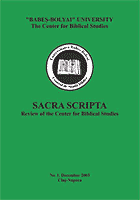The Role of the Neaniskos in the Easter Mystery according to Mark
The Role of the Neaniskos in the Easter Mystery according to Mark
Author(s): Attila ThordaySubject(s): Christian Theology and Religion
Published by: Universitatea Babes-Bolyai - Centrul de Studii Biblice
Summary/Abstract: In the Markan passion and resurrection narrative there are two refferences to a certain neani,skoj. The evpi. gumnou/ is missing partly or completely from 14:51 in the most notable Western witnesses. Some scholars suggest that the nakedness should be interpreted as “scanty clothing” Textual criticism shows that this proves to be facile. Undressing is a painful step of the transition made by the disciple of Jesus, which corresponds to Jesus’s kenosis (cf. Fil 2:6-8; 2Co 8:9). Upon the arrest of Jesus, the escape of the young man naked flashes the purport of being a disciple. Examination points out to three key words (neani,skoj; periba,llw; feu,gw) returning in 16:1-8. A parallel is drawn between the young man running away naked and the young man appearing in white clothes (cf. 16:5), as well as between the women running away, full of fear, and the heavenly messenger. On the one hand, the disciples are characterised by “unredeemedness”, on the other, the young man dressed in a white robe appears as the messenger of redemption. 14:50-52 foreshows the passion and death of Jesus by the sign of being stripped naked in the human and spiritual sense. The neaniskos in 16:5-7 is the icon of the disciple, strengthening the disciples to have the courage to live the fullness of the Easter mystery. Subsequently the texts may have been used for baptismal education.
Journal: Sacra Scripta
- Issue Year: III/2005
- Issue No: 1+2
- Page Range: 63-72
- Page Count: 10
- Language: English
- Content File-PDF

